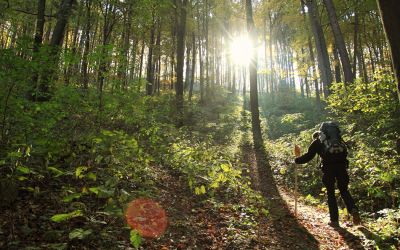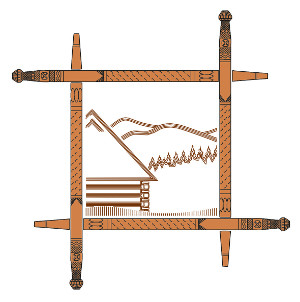Trails and roadless tracts of the Low Beskids

Opis produktu
ROUTE NAME: Trails and roadless tracts of the Low Beskids
ROUTE TYPE: walking trail, active tourism
ROUTE TARGET GROUP: route recommended for mountain hikers
DIFFICULTY LEVEL: route for middle-experienced cyclists
ROUTE COURSE:
Dukla - Cergowa (716 m a.s.l.) – Zawadka Rymanowska – Piotruś (728 m a.s.l.) – Stasiane – Tylawa – Zyndranowa – Czeremcha – Lipowiec –Jaśliska
ROUTE DESCRIPTION:
Day 1
We start the first day of our hiking trip in Dukla which is crossed by the former "Hungarian trail" - wine trade trail. We can visit e.g. the Market with the Renaissance town hall here, as well as the palace complex with a park or the Sanctuary of John of Dukla and Monastery of St Bernardine from the eighteenth century. Then we follow the yellow trail through Cergowa (716 m a.s.l.) to Zawadka Rymanowska. The village is divided into a system of lans (measure of land) in which each of the households had a strip of land stretching perpendicularly to the boundaries of settlements and the residential building was situated by the road, in the middle of the land. Traditional Lemko homesteads from the late nineteenth and early twentieth century remained here. Most of the builiding present a traditional log frame structure with saddle notch corner joints and "fishtail" corner joints. The former Greek Catholic Orthodox church of the Birth of the Blessed Virgin Mary also survived here. After visiting this village, we return to the yellow trail and go to the top of the Piotruś mountain where, after getting to the ridge, a long section leading to the summit runs through the sandstone bar. Blocks of rock which we walk around are often over 4 meters high. One legend even says that in the early twentieth century, stone that can be found here was used to build a church in Lubatowa. The trail from the Piotruś mountain (728 m a.s.l.) leads us to the village of Stasiane. Tourist shelters, as well as a fireplace and a campsite, can be found here. Then we go to a nearby town - Tylawa.
Day 2
On that day we go from Tylawa to the next Lemko village located on the Polish-Slovak border, namely - Zyndranowa which we should necessarily explore. The village stretches along the Panna stream and it is surrounded by wooded hills cut by mountain streams. At the end of the 16th century, it was one of the largest Vlach villages in the Low Beskids. In the post-war period, many farms were destroyed. The Museum of Lemko Culture was established in one of them. Its origins date back to the 1950s. After visiting the museum, it is also good to visit the Orthodox church of St. Nicholas which is the first Orthodox church built in the area of Lemkivshchyna after World War II. Walking around the village, we pass the crosses standing alone among fields and meadows by the old roads and reminding us of the past. Nowadays, there are four active religious denominations functioning in the village: Roman Catholic, Orthodox (autocephaly), Greek Catholic and Jehovah's Witnesses. Therefore, it is good to stop here overnight and get to know these people and their culture.
Day 3
We walk into Zyndranowa to reach the trail that will lead us to the villages that do not exist anymore - Czeremcha and Lipowiec. They were founded in 1527 in a rather wide valley of the Bielcza stream, based on the Vlach law. In 1880, around 420 people lived in Czeremcha and the vast majority (380) of them were Lemkos. The main occupation of the population was pasturing cattle. After the war, the inhabitants of the village were displaced to the USSR. Few traces of the former inhabitants survived in the valley: remnants of an Orthodox church, several tombstones from the old cemetery, roadside crosses, ruins of the watchtower. The next village is Lipowiec. It used to be a populous Lemko village but now it is an almost empty valley in the Low Beskids. One of the chapels is associated with a revelation, which resulted in the developed of the pilgrimage movement that continues until today. Going through the valley we pass the remnants of orchards and avenues of willow trees. After wandering through the deserted valley, we get to Jaśliska - a former fortified border town. It is good to stop here for quite a while before going back and to visit e.g. the remains of the ramparts from the 16th and 17th centuries, St. Catherine's Church and the historic wooden complex of buildings with an urban layout of a former town which was included in the Sub-Carpathian Wooden Architecture Trail.
STAGES, LENGTH AND ESTIMATED TIME OF WALKING:
Day 1
Dukla – Cergowa [1:50 h; 4.6 km]
Cergowa – Zawadka Rymanowska [00:50 h; 3.3 km]
Zawadka Rymanowska – Tylawa [3:30 h; 10.8 km]
Day 2
Tylawa – Zyndranowa [00:50 h; 4 km]
Day 3
Zyndranowa – Czeremcha [2:05 h; 6.8 km]
Czeremcha – Jaśliska [1:45 h; 4.8 km]
DESCRIPTION OF OBJECTS:
SANCTUARY OF ST. JOHN OF DUKLA AND BERNARDINE MONASTERY - it is a prized sacred complex and a main place of worship of St. John of Dukla, a saintly monk from a Bernardine province from the 15th century. The church is a building with three naves, basilica-type layout and presbytery ended with a semicircular apse. The style of the church interior was transformed into a neo-Renaissance style, it is divided by double pilasters and columns supporting the cornice with an entablature. The central nave open in the direction of side aisles with semicircular arcades. A carved crucifix can be found in the main altar.
ORTHODOX CHURCH OF THE MOST BLESSED VIRGIN MARY IN ZAWADKA RYMANOWSKA - former Greek Catholic Orthodox church built of wood in 1855. The Orthodox church is a tripartite and oriented structure, with a log frame structure. It is clearly divided into the vestibule, nave and altar room, all parts being elevated to the same height, however, the nave is wider than the other parts. The gable roof is covered with a sheet metal and has one ridge. There is a tower with a wooden frame structure above the vestibule and small domes above the nave and chancel. A five-storey iconostasis from the 18th century with icons of W. Buczkowski survived in the interior of the former Orthodox church.
MUSEUM OF LEMKO CULTURE IN ZYNDRANOWA - founded in 1968 owing to the efforts of an indigenous inhabitant of Zyndranowa, Teodor Gocz. The hut dating from 1860 is the main site of the open-air museum. The interior of the hut is a reconstruction of the rural scribe office with archives, books, letters and photographs from the area of Lemkivshchyna. In the so-called chamber, sacral exhibits were collected, such as pieces of cast iron crosses, vestments, copies of icons. There also is a rich collection of Easter eggs decorated with the traditional Lemko patterns. Among farm tools and objects, you can see flails, looms, millstones. The Museum has also collected war memorabilia after the operations on the Dukla Pass.
SAINT NICOLAS ORTHODOX CHURCH IN ZYNDRANOWA - parish Orthodox church. Brick building divided into three parts (porch, nave, chancel), in the Lemko style. It was built in the years 1983-1985 and consecrated in August 1985, and it became the first Orthodox church built in Lemkivshchyna after World War II. In 2015 a dome was placed above the entrance to the temple.
WOODEN BUILDINGS IN JAŚLISKA - wooden Upper Lusatian houses with walls connected with the use of "fishtail" corner joints, the gable walls of which are set in the direction of the square, which is characteristic of small-town building development. Houses consist of two sections - one section which constitutes the living part consists of a chamber, larder and bedchamber and the second section consists of an entrance hall with the threshing floor. The three oldest houses (from the mid-nineteenth century) preserved in the south-western frontage. At the corner of Rozpatrz and Traktu Węgierskiego streets, we can see an Upper Lusatian house with a shingled roof - one of the oldest huts in Jaśliska.
EVENTS:
Zyndranowa
July/August - „Od Rusala do Jana”
Olchowiec
May – “Kermesze Łemkowskie” (EN. „Lemko indulgence)
Dukla
June - Sobótkowe Spotkania z Folklorem, Targi Rzemiosła i Rękodzieła Artystycznego (EN. Midsummer Night’s Folklore meeting, Crafts and Handicraft Fair)
August – “Cyklokarpaty Dukla”
Komańcza
August – Spotkania przygraniczne Polski i Słowacji (EN. Polish and Slovak border meetings)
Radoszyce
July - "Radoszyckie źródło" - Spotkanie przy granicy (EN. “Radoszyce spring” – Meeting at the border)
WHERE TO STAY AND EAT:
FARFURNIA
Zawadka Rymanowska 40 d, 38-450 Dukla
phone: +48 13 4330183, + 48 502 337768
“Nad Panną” Agritourism Farm
Zyndranowa 23, 38-454 Tylawa
phone: +48 13 433-11-63, 695-101-957
www. nadpanna.pl
Zajazd DOMENICO
Tylawa 28A, 38-454 Tylawa
e-mail: kontakt@domenico-tylawa.com
phone: +48 13 43 355 77
CZEREMCHA BAR
Rynek, 38-485 Jaśliska
phone: +48 507 076 332
"DZIKIE WINO” AGRITOURISM FARM
Daliowa 13 38-485 Jaśliska
e-mail: annakochman2@gmail.com www.facebook.com/winodzikie
Dodatkowe informacje
WHERE TO EAT AND SLEEP:
FARFURNIA
Zawadka Rymanowska 40 d, 38-450 Dukla
tel .: 013 4330183, 502 337768
Agrotourism Nad Panna
Zyndranowa 23, 38-454 Tylawa
tel .: 13 433-11-63, 695-101-957
www. nadpanna.pl
DOMENICO Inn
Tylawa 28A, 38-454 Tylawa
E-mail: kontakt@domenico-tylawa.com
tel .: 13 43 355 77
CZEREMCHA BAR
Rynek, 38-485 Jaśliska
tel .: 507 076 332
AGRICULTURE AGRICULTURE
Daliowa 13 38-485 Jaśliska
email: annakochman2@gmail.com















